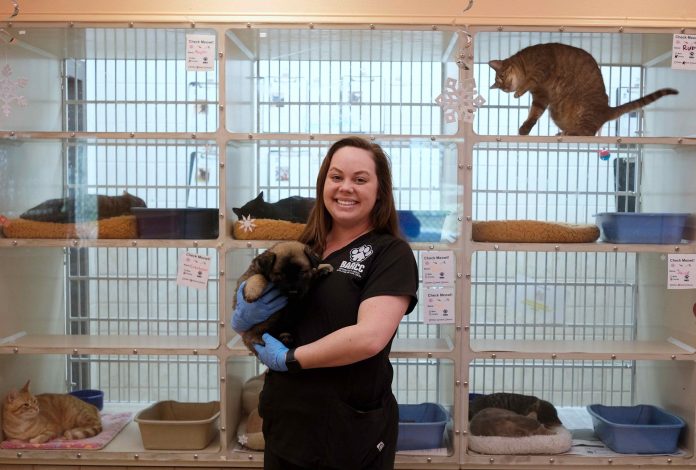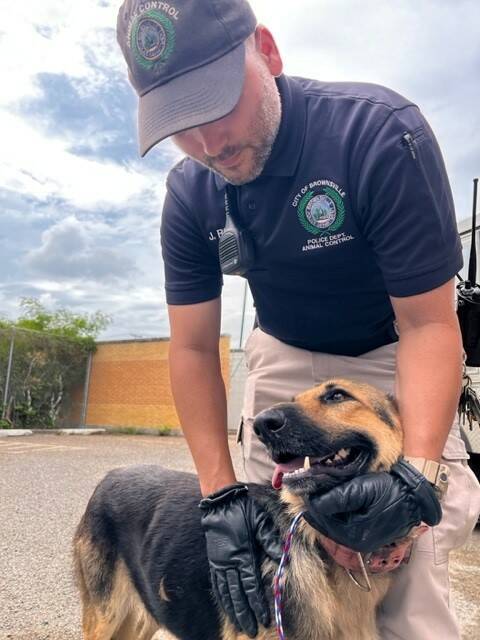
|
Only have a minute? Listen instead
Getting your Trinity Audio player ready...
|
The Brownsville Animal Regulation and Care Center (BARCC), the city’s animal shelter, has achieved something that even a year ago would have seemed unattainable: a 90% save rate.
Best Friends Animal Society, a national animal welfare organization BARCC has been working with to enshrine best practices toward driving down the kill rate, announced the news this month. BARCC hit the 90% mark in March. BFAS considers a shelter “no-kill” once it reaches and maintains a 90% save rate — meaning saving every animal is saved that can be saved — for at least four months.
BFAS says it is dedicated to ending the killing of dogs and cats in U.S. animal shelters by 2025.
“Adopting a pet in need and giving them a home is a compassionate choice that helps provide homeless dogs and cats in the Rio Grande Valley with a second chance,” the organization said in announcing the news.
Antonio Caldwell, BARCC’s director of health and wellness animal services, said that when he joined the shelter a year ago, an examination of its records revealed dismal save rates of 20-30% over BARCC’s history.
“We were euthanizing sometimes 300, 400 animals a month historically,” he said. “Those are the types of things that just kind of chill you to your bone, when you think about the lives that are lost.”
The city of Brownsville contracted with BFAS to help establish best practices for boosting the shelter’s live-saving capacity, one of the — one of the most significant being a change in BARCC’s intake process, Caldwell said. The shelter still takes in sick, injured or potentially dangerous animals, though healthy and non-threatening strays are returned to their owners by animal control officers when possible rather than being transported to the shelter, he said.
As a matter of policy, officers now scan stray animals in the field to check for a chip, which contains owners information, Caldwell said.
“It might mean if you pick up a stray to be observant and drive around the neighborhood a few times, because typically people are out looking for that animal,” he said.
Another big factor is BARCC’s burgeoning partnerships with rescue groups outside the Valley and even the state, which sometimes will take 30-50 cats and dogs at one time off the shelter’s hands, Caldwell said. BARCC has also upped its social media game, growing the number of follows by nearly 5,000 in the past year, he said. In addition, BFAS sponsors adoption fees a couple of times a year to remove that barrier to adoption, Caldwell said.

Taylor Lefebvre, of BFAS, who embedded with Brownsville’s shelter for the past year, said a major focus has been making sure every animal coming in gets the same level of care and intake vaccines against diseases like parvovirus and distemper — endemic in South Texas. That way, animal rescue centers feel a lot better BARCC animals, whereas in the past rescue operations may have unknowingly received sick animals from the shelter.
“They know what our intake protocols are,” Lefebvre said. “They’re getting their full medical histories. We’re reviving some of those relationships as well.”
“We want to make sure our population is as safe as possible, making sure each animal we are evaluating for its individual needs,” she said. “Some animals need more enrichment and more work to make them adoptable or keep them as calm and happy as possible while when they are in the shelter. Those are two things we’re really focused on.”
BARCC also now has next-step plans in place for every animal brought in, perhaps puppies that need to go right into foster care, a specific breed that a rescue might take, or uncomplicated, inexpensive adoptions that can be fast-tracked, Lefebvre said.
“We want people to choose to adopt from the shelter,” she said. “We are open six days a week. We want people to come see the shelter. We want people to meet our animals. We want them to be confident about when they are adopting from here that they are getting a healthy, friendly animal that they can integrate into their home, and that we will help them integrate into their home.”
BARCC’s community adoption events are also a good way to get people in, Lefebvre said, adding that “we are excited when people walk through the door and we want people to feel that.”
A big part of turning things around at BARCC has been simply getting the word out that the shelter even exists, she said.
“When I moved here a year ago and I said where I was working, a lot of people would say, oh, the shelter in Harlingen or the one in McAllen? I said, no, you have a local shelter right here. Please come visit it,” Lefebvre said.




